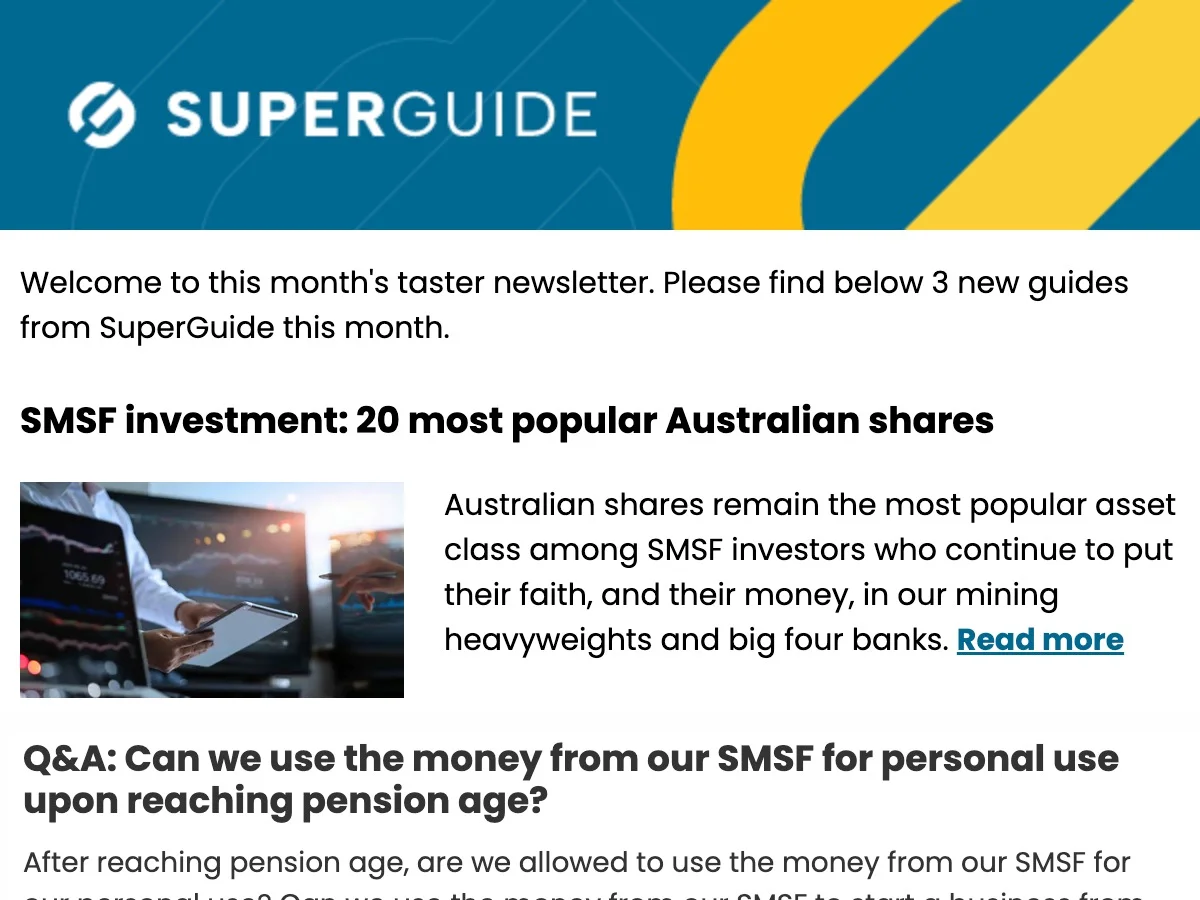In this guide
With the latest ATO research showing nearly 14,000 SMSFs are wound up each year, it begs the question; what are your options if you no longer want to manage your own super fund?
People wind up their SMSF for lots of reasons. Sometimes it’s due to personal circumstances, and sometimes they simply find the work involved too onerous.
Whatever the reason, it’s important to know what your options are when the time comes to wind up your SMSF and the other types of super funds available if you plan to rollover your money.
Reasons for winding up
Even though it gives you direct control and allows you much greater input into how your retirement savings are invested, there are ever-changing rules and lots of paperwork to complete and get right.
Trying to follow the ups and downs of investment markets and ensuring you achieve a good investment return is also time-consuming. Some SMSF trustees find they lack the expertise – or overall fund balance – to achieve the necessary returns.
2026 SMSF calendar
Our free calendar includes due dates for important documents plus suggested dates for trustee meetings and other strategic issues for your SMSF.
"*" indicates required fields
Trustees of smaller SMSFs may even find running their own fund is not cost-effective compared to other fund options.
According to SMSF experts, common triggers for winding up an SMSF are:
- Death of a trustee
- No members remaining
- Relationship breakdowns
- Loss of trustee capacity
- Failing health and disability concerns
- Disinterest
- Disqualification due to bankruptcy
- Disqualification by the regulator
- Relocation overseas and trustee non-residency.
How can I overcome my fund’s problems?
The SMSF Association has studied the issue of SMSF trustees who are considering winding up their fund and has some potential solutions to the common problems funds can face.
Considerations to think about before winding up your SMSF
| Reason for winding up | Options or possible solutions |
|---|---|
| Low fund balance | Introduce another suitable member to the fund |
| Difficulty obtaining insurance | Review the cost of losing the current insurance benefits in your SMSF and consider whether you will be able to obtain similar cover elsewhere |
| Costs | Compare the cost and performance of an alternative fund option with your current SMSF |
| Investment performance | Consult a financial planner to check if your investment strategy and mix are optimal if your investments are performing poorly |
| Too much work | Consider outsourcing some administrative responsibilities for managing the fund to a SMSF Specialist Advisor |
| Limited recourse borrowing arrangement (LBR) | Review the cost of selling an asset purchased through a LBRA and winding up the arrangement, as these cannot usually be transferred to a new super fund |
| Fund losses | Introducing a new member may allow accumulated CGT losses to be utilised by the SMSF, but winding up will result in them being permanently lost |
Source: SMSF Association
Seeking independent professional advice is generally recommended before making any major decisions about winding up your SMSF.
Experienced advisers can help you work through all the options. These could include introducing a new member (particularly now you have the option of a six member SMSF), or reworking your asset allocation and investment strategy if your investment returns are low.
You may also need help to think through the implications of dealing with the remaining super benefits in the fund, the tax implications of any asset disposals, and what the rules in the trust deed require when it comes to winding up your SMSF.
Winding up an SMSF is complex and, depending on the assets involved, can be costly. So it’s essential to tick all the boxes when it comes to tax, stamp duty, compliance requirements, payment of member benefits, fund audits, pensions and financial statements.
What super fund options are available?
If you do decide to close your SMSF and roll your retirement savings into another super fund, you have two main choices:
1. Small APRA funds (SAFs)
SAFs can be a good choice for SMSF trustees who are looking to close their fund but aren’t keen on joining a large public-offer super fund.
A SAF is an SMSF with a professional trustee rather than the fund members being the trustee. This means the role of trustee and the responsibility for managing the super fund on behalf of its members is passed to a licensed trustee company.
The trustee company takes on full responsibility for the compliance, regulatory reporting and administration of the SAF, removing much of the burden of running the SMSF from the fund members.
Supercharge your SMSF

"*" indicates required fields
If you move to a SAF structure, your fund can retain any illiquid and lumpy investments (such as private company shares, business-real property and collectables) within the fund. Typically, these types of assets are not accepted by retail or industry funds.
One of the key benefits of changing the trustee of an existing SMSF to become a SAF is that the shift doesn’t have implications for the grandfathering of any existing super pension benefits. The SAF continues the existing pension arrangements, so your social security benefits are untouched.
A SAF can also be a good solution if one of the trustees has lost mental capacity, as you cannot remain an SMSF trustee if you lose capacity. The same applies if a trustee plans to move overseas, which can result in the SMSF no longer meeting the central management and control or Australian residency requirements for SMSF compliance.
2. Direct investment option within a large super fund
If you want the ability to actively manage your super and retirement investments but avoid the administrative work involved with a SMSF, a direct investment option (DIO) within a large public-offer super fund could be another option to consider.
Many of the larger retail and industry super funds now offer DIOs within their fund, allowing members to take greater control of their super investments. These options generally offer access to real-time trading, extensive market information, independent research and investment tools.
If you are advised by a financial planner, you will likely be offered an individually managed account with an investment platform. Traditionally, these have been owned by banks and major financial institutions. But in recent years, the likes of BT Panorama, CFS First Choice and Macquarie Wrap have been challenged by entrepreneurial newcomers such as Netwealth, HUB24 and Praemium.
If you are keen to be actively involved in managing your super investments but want all the paperwork taken care of by someone else, a DIO could be worth considering.
The DIO structure allows former SMSF members to combine directly selected investments (like shares and exchange traded funds) with asset classes normally unavailable to smaller SMSF investors (such as infrastructure or international property).
With a DIO, fund members are free to tailor and create highly personalised investment strategies.
Common assets available in these options include:
- Directly selected Australia shares
- Exchange traded funds (ETFs) covering a variety of international and Australian asset classes
- Listed investment companies (LICs)
- Term deposits
- Cash
- Single asset class options offered by the fund
- Pre-mixed investment options offered by the fund.
The main benefit of choosing a DIO is the super fund – rather than you – is responsible for all the administration, compliance and reporting requirements associated with your super or retirement account.
There are usually no set-up costs with a DIO and the funds offering these options claim their ongoing fees are low.

Free eBook
SMSF investing essentials
Learn the essential facts about the SMSF investment rules, how to create an investment strategy (including templates) and how to give your strategy a healthcheck.
"*" indicates required fields

Leave a Reply
You must be logged in to post a comment.